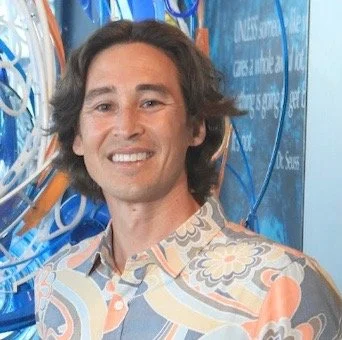The Triangle That Explains the Problems You Keep Solving Twice
You know that feeling when everything is technically working, but not quite clicking?
Maybe you’re in that stretch right now.
The business is doing objectively well.
Revenue is steady, if not growing.
Your team is solid.
You’re delivering great work, and you’ve got the wins to prove it.
And yet…
Somewhere between where you were and today, the gears started to grind just a little bit.
Nothing super dramatic - just subtle enough that you can feel it.
A project that used to flow now needs three check-ins.
Handoffs that were once effortless now require a couple of meetings.
People are still performing, but they’re feeling stretched.
You’re genuinely proud but you’re also tired in a way you didn’t expect.
You’re in the zone where that quiet pressure emerges right before your company grows into the next version of itself.
You’re in the in-between zone.
The place where the system that got you here starts to strain under what’s coming next.
Where things aren’t technically “wrong enough” to call it a problem…but everything takes more energy than it should.
Or maybe you’re on the other side:
Doing the same thing that made you successful, only now the effort has doubled but the return hasn’t.
Either way, the feeling is the same:
“This shouldn’t be this hard.”
And here’s the truth most leaders never hear:
You’re not staring down a crisis. You’re standing at a crossroads.
And the way forward isn’t another app, tool, or strategy sprint.
“And the way forward isn’t another app, tool, or strategy sprint.
It’s understanding where the tension really lives…
which part of the business is quietly out of balance…
and how to realign it so the organization can move forward again with clarity and momentum.”
And every leader reaches this moment eventually - the point where the effort exceeds the ease.
The good news?
There’s a structure underneath that shift.
Understand it, make a few focused adjustments, and your organization can start moving smoothly again.
TL;DR - Your Business Is a Triangle
Every healthy business runs on three sides:
People. Culture. Infrastructure.
When all three are strong, work feels lighter, smoother, and more fun (more human).
When one side wobbles, friction shows up (rather quickly), resulting in slower decisions, recurring fires, and unspoken tension.
Strengthen the side that’s lagging, and things start to click again.
Let’s walk the triangle together.
The 3 Sides (and What Happens When One Wobbles)
At the center of the triangle sits what you really want:
“Happier people, better results, and work that feels less like work, with a business (and team) that grows reliably and more effortlessly…
and a life where you can fully unplug, take real time, and be fully present for the things outside of work that make it all worth living.”
Each side plays a different role:
People = Fit, Capacity, Growth
Culture = Beliefs, Behaviors, Trust
Infrastructure = Structure, Systems, Rhythms
Understanding your strong sides (and your wobbly side) reveals the fastest path to your next level.
PEOPLE - Fit, Capacity, Growth
Your business is a living system built from people whose strengths run deeper than their titles.
The People side asks YOU to consider:
Do we have the right people, in the right seats, with the capacity and support to win and grow?
When your People side is strong, you hear:
“I know what success looks like. I’m trusted, supported, and growing.”
When it’s weak, you land in:
The Comfortable Plateau
(Strong Culture + Strong Infrastructure, Wobbly People)
You’ve built a genuinely good place to work. Systems run smoothly, and people get along. But not everyone is fully in the right seat or pulling the same weight.
What it feels like:
Results are “fine,” but not exceptional
Leaders avoid hard feedback to ”keep the peace”
Top performers quietly carry the extra load
The hidden cost:
The kindness that makes the team great can start to blur accountability.
Your next move:
Define what “success” looks like for each role
Lean into behavioral- and performance-based growth conversations
Re-seat, coach/upskill, or release people to be excellent elsewhere, as needed
Example in action:
A 24/7 business services team delivered decent results, but people were rowing in different directions without realizing it, slowing decisions and diluting momentum.
When leaders clarified and openly shared a compelling vision, the team finally understood what they were building - and how the company’s growth was not only a path to improving the world around them but also to achieving their own personal and professional goals.
With a clear 3-year vision - supported by coaching and role clarity - the spark came back. People leaned in, owned their work, and showed up energized. Results climbed, clients noticed the difference, confidence spread through the team, and profitability followed. It was a vivid example of how a unified vision and intentional talent development systems strengthen the People side of the triangle.
Lesson:
Clear vision and talent development encourage the full potential of your people, turning daily routines into growth opportunities.
CULTURE - Beliefs, Behaviors, Trust
Culture is how it feels to work here - especially when it comes to how people behave (and feel) when things get hard.
When Culture is strong, people say:
“We can tell the truth here, even when it’s uncomfortable.”
When it’s weak, you end up in:
The Tight Ship
(Strong People + Strong Infrastructure, Wobbly Culture)
You’ve built a machine that runs. Metrics are solid. Systems are tight. You have a smart, capable team, but under the surface, everyone’s a little guarded and unsure of themselves (or others on the team).
What it feels like:
Efficient meetings, cautious energy
People choose words carefully
Issues surface later than they should
The hidden cost:
Creativity and trust quietly drain away.
Your next move:
Start meetings with a people-focused check-in
Recognize the effort (and the how) behind wins, not just what got done
Leaders model vulnerability (“here’s what I learned from a mistake…”) and a solution-focused mindset
Example in action:
A fully remote agency delivered solid work, but inconsistent leadership behavior (and communication) created doubt and slowed collaboration amongst the team.
Team members sugarcoated problems, afraid of coworker blamestorming and leadership pushback.
A team retreat, plus 1:1 coaching helped leaders identify blind spots, release the “need” to know everything and drop the mask (by being comfortably vulnerable), so they could communicate more effectively, foster trust, and get more done through better relationships.
Once people began speaking openly, solutions emerged faster, morale improved, and projects flowed more smoothly, showing how effective communication and getting clear on ideal behaviors and communication rhythms strengthens the Culture side of the triangle.
Lesson:
Building trust and encouraging open communication transforms latent tension into smoother collaboration.
INFRASTRUCTURE - Structure, Systems, Rhythms
If People are the players and Culture is how you play together, Infrastructure is the friendly scaffolding that helps great people do great work, consistently.
When Infrastructure is strong, people say:
“Our systems make our work easier - they don’t slow us down.”
When it’s weak, you’re living in:
The Caring Chaos
(Strong People + Strong Culture, Wobbly Infrastructure)
You’ve got heart, talent, and momentum. People love the mission and each other, but everything runs on memory, heroics, and best intentions.
What it feels like:
New hires feel welcomed and overwhelmed
Projects take longer than they could or should
Your best people are constantly “saving the day”
The hidden cost:
Inconsistent outcomes. Hero fatigue. Painful scaling.
Your next move:
Document simple processes for recurring work
Clarify decision rights (“If X, then Y decides”)
Create predictable rhythms (weekly huddles, project check-in)
Example in action:
A community-focused retail team struggled with inconsistent hiring, bringing in the wrong people or losing talent too quickly.
Implementing structured hiring, onboarding, and training systems created stability.
They kept great people, built a solid foundation, and grew confidently - showing how clear and repeatable systems and processes strengthens the Infrastructure side of the triangle.
Lesson:
Reliable systems turn talent and culture into sustainable growth and stronger results.
What’s In it for You?
Picture your organization 90 days from now, with the wobbly side stronger than it is today, where:
PEOPLE
Everyone knows what success looks, acts and feels like
Workloads feel manageable and predictable, rather than inconsistent or stretched
Your team thrives instead of quietly struggling
CULTURE
Meetings feel lighter, more honest, and more human
There are fewer surprises- people speak up early, not after the fact
There’s more trust, more clarity, more momentum.
INFRASTRUCTURE
Projects flow without heroics
Decisions are made quickly and with confidence instead of bouncing around like hot potato
Your have more mental, emotional, and physical energy because you’re not fighting fires as frequently
And you?
You’re spending more time leading forward and less time managing the same problems on repeat.
That’s what it feels like when the triangle comes back into balance.
Not perfection - just flow.
What’s Your Side? / Which Side is Calling for You?
(Link to lead magnet)
Take 2 minutes to rate each side from 1💩–5🤩.
Whichever score is lowest - that’s your growth edge for the next 90 days.
Big changes don’t come from a single overhaul.
It comes from a few small, intentional moves done consistently, over time.
How This Looks in Real Work Life
This triangle is the quiet framework underneath almost every team we support.
It helps us get past surface symptoms and see what’s actually creating drag - and where the biggest, most immediate lift is hiding.
On each team, the work looks different, but usually involves:
Clarifying roles, expectations, and capacity
Strengthening trust and agreements
Tightening operating rhythms and decision flow
The details may shift, but the pattern doesn’t:
Find the wobbly side.
Strengthen it with small, intentional, people-focused moves.
Watch the your team, your company, and your available energy rise.
Want to Explore Your Triangle?
If you’re reading this thinking,
“Yep… that’s me,” or “Yep…that’s us,”
you’re in good company. Almost every team hits one of these patterns at some point.
If you’re curious where your biggest opportunity sits right now, click below and tell me:
Which two sides feel strongest?
I’ll send you a few ideas of where you can start strengthening the wobbly-side of your triangle.
Here’s to building organizations where,
the work flows,
the people grow,
the results follow, and
and you have the energy to show up fully - in work and in life.
Cheers,
Marty Imes
Founding Partner






